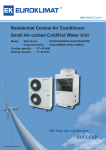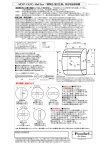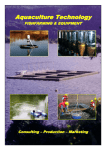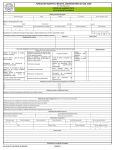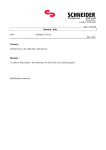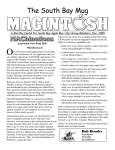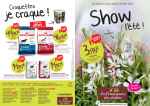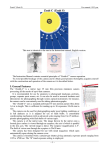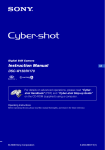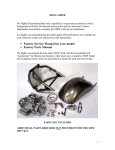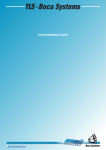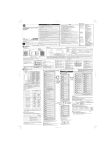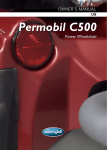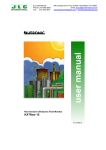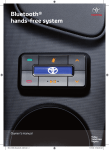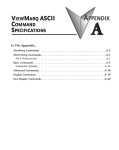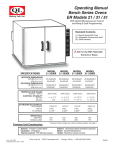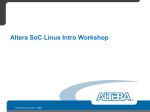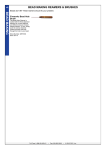Download AFE OMRON Operating Manual REV 0415 .ai
Transcript
Model AFE Digital Series Lab Ovens With Microprocessor Control & Digital Display Quincy Lab, Inc. OPERATING MANUAL Standard Contents (1) AFE Series Lab Oven (2) Adjustable chrome wire shelf (4) Shelf brackets Not For Use With Flammable Solvents or Gases. Lab Oven Model 30AFE Quincy Lab, POWER Inc. DIGITAL MICRO PROCESSOR Switch opening Menu Enter/Exit l Menu Scrol int ecrease Setpo Increase/D CMW MANU STOP TUNE GCE SERIE PF E5GC S (PRESS) OMRON SPECIFICATIONS INTERIOR DIMENSIONS INCHES W x H x D (CM) W x H x D MODEL 10AFE MODEL 20AFE MODEL 30AFE MODEL 40AFE 12x8.63x10 13x11.63x13 30.5x22x25.4 33x29.5x33 18x14.63x12 18x19.63x14 45.7x37x30.5 45.7x50x35.5 15x24.5x15 14x20.5x12 35.5x52x30.5 38x61x38 20x28.5x14 20x33.5x16 52x72.4x35.5 52x85x40.63 EXTERIOR DIMENSIONS INCHES W x H x D (CM) W x H x D TEMPERATURE RANGE Ambient + 25 F to: F / C 450 /232 450 /232 450 /232 450 /232 0.5 / 1.0 0.5 / 1.0 0.5 / 1.0 0.5 / 1.0 120/6.6* 800 5-15P* 120/8.8* 1050 5-15P* 120/12.5* 1500 5-15P* 120/12.5* 1500 5-15P* 44 38 61 54 78 70 94 85 CONTROL STABILITY Typically +/- F / C STANDARD ELECTRICAL VOLTS/AMPS WATTS PLUG/NEMA WEIGHT (lbs) SHIPPING STAND ALONE * Standard models voltage only, optional 220 voltage available. Check label on back of unit. Common Unit Construction Exterior: Powder Coated Steel Insulation: Fiberglass Thermo-control: PID Microprocessor Issue AFE 0415 Copyright Quincy Lab Inc. 2015 Interior: Aluminized Steel Motor: Sleeve Bearing, Thermally Protected Heater: Resistive-Tubular Incoloy Quincy Lab Inc. 1925 N. Leamington Ave. Chicago, Illinois 1-800-482-HEAT (4328) PAGE 1 Safety Precautions Read Operating Instructions Thoroughly Prior to Operation The AFE Series lab ovens are not designed for use with any flammable solvents or gases or for materials that may contain flammable solvents or gases. Use only a grounded outlet that is rated for your model's electrical requirement. Oven exterior walls and doors may become hot to the touch when operating at higher set temperatures. Do not leave the oven unattended during operation, especially when processing materials that have flash point temperatures lower than the model oven's maximum operating range. Do not modify the oven or control parameters to operate the oven above the stated maximum operating temperature. Set-up Position unit in its ultimate operating location. Keep a minimum of 2" of airspace around the unit and a minimum of 10" above the unit. Important: The exhaust ports should NOT be used as chamber access for temperature-measuring probes. Insertion of any such probe or device may damage or unbalance the circulating fan blade at the top of the oven chamber. Install adjustable shelf by placing the ends of the wire shelf bracket into the corresponding holes located on the inner sides of the oven at the desired height. Push the ends of the bracket into the holes until the first bends in the bracket are against the wall, then rotate the bracket down. Place the shelf on the brackets. (FIG 1) A B C D FIG. 1 Plug the unit into a grounded outlet for your unit's rated voltage. General Operation The unit is ready for your immediate use. All control parameters, calibration and tuning has been done at the factory, no adjustments are necessary. Push the illuminated power button. The fan motor will start. All LED's on the temperature control will light up immediately and display the current chamber temperature and the set temperature. Set temperature is constantly displayed in the lower righthand corner of the display. To change the set temperature, simply press either the up arrow key or the down arrow key, until desired set temperature is reached (FIG 2). The temperature control is set at the factory to read in 1/10 degree F or Fahrenheit units. To change temperature units or display resolution, see Menu Level Functions (page 3). F CMW MANU STOP TUNE PF OMRON E5GC Enter/Exit Menu Menu Scroll Increase/Decrease Setpoint (PRESS) FIG. 2 Once the unit nears the desired temperature allow the unit to cycle for 20 minutes at set point before temperature becomes fully stable. NOTE: Upon each initial powering-up, the control may typically overshoot the set temp by 3 or 4 degrees especially if the temperature set point is close to the operating ambient temperature. After equilibrium is achieved the control will hold set temperature within 1 unit degree. Chamber Loading Article processing times and temperature uniformity are largely dependent on load density and positioning. Load the oven so that air circulation within the oven is not impaired. Here are some general guidelines: Continued on insert.... PAGE 2 Model AFE Digital Series Lab Ovens With Microprocessor Control & Digital Display Quincy Lab, Inc. OPERATING MANUAL INSERT Chamber Loading Article or media processing times and temperature uniformity are largely dependent on load density and positioning. Load oven so that air circulation within the oven is not impaired. Here are some general guidelines: Leave a space between multiple articles on a shelf. Position articles on shelves as shown in (FIG 4), for best results avoid placing articles or media against or within an inch of the walls, especially on the lower shelf, allowing unrestricted air flow around articles and contributing to even and consistent heating. Use of large solid trays, or foil on shelves severely limits the oven's ability to distribute heat evenly and uniformly. (FIG 5) Since not enough heat rises within the chamber, thermometer readings give false indication that temperature setting is too low. Higher temperature adjustments made as a result of these readings could overheat the lower-placed articles or media. Ideal Circulation Obstructed Circulation Heater Rear fresh air intake vents FIG. 4 FIG. 5 Do not overload the unit with large (in quantity OR size), or high-density loads. This will show by non-uniform processing and long or impossible "heat-through" times. To help determine a large load's suitability, compare the time it takes for the temperature to recover to the original empty chamber set temperature once load is placed. To reduce recovery time, reduce load accordingly. Also, large loads such as a beaker containing 2 liters of solution, may require an elevated set temperature for the solution to reach and maintain a lower target temperature. Care should also be taken to avoid placing items on the top-most shelf too close to the holes in the fan plenum. This will restrict the flow of air passing through the plenum and reduce the amount of pre-heated air being circulated through the entire chamber and cause longer than normal heat-through times and inconsistent or unstable oven temperatures. For best processing performance for a single item, adjust one shelf so that the article is centered in the oven chamber. NOTE: The unit's minimum operating temperature is largely determined by ambient temperature. The unit can operate 25 degrees F (approximately 14 degrees C) above room temperature but temperature stability may be degraded. Temperature stability improves appreciably for settings that exceed ambient by 30 degrees F or better. As a general rule, the lower the ambient temperature, the lower the maximum adjustable operating temperature. Issue AFE 0714 Insert Copyright Quincy Lab Inc. 2014 Menu Level Functions Guide To access menu for common menu functions, please refer to Menu Guide below: Menu setting changes are quick and easy with the our new 5-button digital microprocessor. Through the use of these controls you can: set the operating temperaure, lock the set-temperature, select either degrees F or C, calibrate your unit to your independent device, slect a different thermocouple type, and auto-tune your oven to your specific application. Digital Controller Function Buttons PF Enter / Exit MENU MENU Scroll To set setpoint temperature Decrease Increase Up and down arrow keys (shown left) are used to increase or decrease set-point control temperature as desired by user To lock setpoint temperature Hold together 3 seconds Lock setpoint by changing to '3' Default set to 0 Changes digit cursor on set temperature Decrease Increase To adjust control to read in C or F temperature units Hold 3 sec. View Hit ONCE Use to choose F or C Default set to F To calibrate control to independent probe/sensor Hit ONCE Hit ONCE To calibrate oven, add (or subtract) the temperature Use keys to differential, to the enter temperature existing iNS value shift in degrees shown at prompt To change thermocouple type Hold 3 sec. Use keys to change type Default set to "J" All Lab Series Ovens are factory equipped with a standard "J-type" thermocouple as the default, but you may change from this type of thermocouple to either a different thermocouple, RTD, or infrared sensor, depending on your particular application. Due to the four-digit LED limit of the display, when changing to some of the alternate device types, you may lose the decimal feature allowing you to view temperatures in tenths of a degree. To Auto-tune oven Hit ONCE All ovens are Auto-tuned at the factory using the 'At-1' option for faster response time. You may, however, want to Auto-tune your oven to your specific application. To do this, once at the 'At' prompt (at left), use arrow keys to initiate either Auto-tune option: 'At-1' (for 40% Auto-tune), or 'At-2' (for 100% Autotune). The 40% Auto-tune (At-1), will stabilize the Use keys to oven temperature quicker and with less 'overshoot' than the 100%, but will be somewhat change setting less precise. The 100% Auto-tune (At-2), will take longer to stabilize oven temperature Default set to 40% but will be more precise, and take a little longer to complete the Auto-tune process. PAGE 3 Control Self Diagnostics ALARM Codes "S.ERR" & "- - - -" Control prompts will only display when a fault or alarm condition exists. ALARM Code "E111" ALARM Code "E333" or Indicates Input Error Check to make sure Thermocouple wiring is connected securely Indicates Internal Memory Error Turn Controller OFF and On. If problem remains, replace Controller Indicates Internal Circuit Error Turn Controller OFF and On. If problem remains, replace Controller Common Replacement Components All replacement components are readily available and are easily replaced in the field. COMPONENT MODEL VOLTAGE PART # COMPONENT MODEL VOLTAGE PART # Motor All 115 Volt 205-2030 Digital Controller All All 401-1230 Motor All 230 Volt 205-2031 Relay All All 401-1233 Rocker Switch All 115 Volt 230 Volt 201-2213 201-2213-1 Fuse (10 amp) 10, 20 All Q-1191 Thermocouple All All 701-6253 Fuse (15 amp) 30, 40 All Q-1190 Friction Catch (set) All All 101-2221 Fuse Holder (red) All All Q-1198 6' Cord & Plug 20, 30, 40 115 Volt 230 Volt 101-1403 101-1403-1 Wire Shelf 10 All 101-1000 6' Cord & Plug 10 115 Volt 230 Volt 101-1603 101-1603-1 Shelf Supports (2) 10 All 101-1001 Fan Blade 10 All 205-1018 Wire Shelf 20 All 201-2000 Fan Blade 20, 30 All 205-2018 Wire Shelf 30 All 101-3000 Fan Blade 40 All 205-3018 Wire Shelf 40 All 201-4000 Fan Blade 3" Heat Sink All All 205-4018 Shelf Supports (2) 20, 30, 40 All 101-3001 Periodic Oven Maintenance The AFE Series Lab Ovens are designed to be virtually maintenance free. But operational safety requires periodic cleaning and chamber temperature accuracy verification. Periodically check the rear air intake vents for dirt or dust build-up. Keep the intake & exit ports clear of obstruction and clean of dust and dirt. Once a year, check the actual oven chamber temperature against a known accurate temperature measurement device. Maintain temperature accuracy to within 5 degrees F of the control setting. Calibrate the control as necessary. To clean exterior and interior surfaces, use a damp cloth or with an all-purpose cleaner. Avoid commercially available oven cleaners. Technical Support If you have any questions or need technical assistance, please contact Quincy Lab Tech Support at: Email: [email protected] Voice: 800-482-HEAT (4328) Fax: 773-622-2282 Quincy Lab, Inc. 1925 N Leamington Ave Chicago, Illinois 60639 Limited Warranty Quincy Lab, Inc. warrants to the original purchaser that this product will be free from defects in material and workmanship under normal use throughout the warranty period. The standard warranty period for this instrument is eighteen months from date of shipment. The instrument warranty is supplemented with a three year warranty on the heating element. Please refer to your invoice or shipping documents to determine the active warranty period. This warranty covers parts & labor (labor at factory only) and shipping cost for replacement parts. PAGE 4





